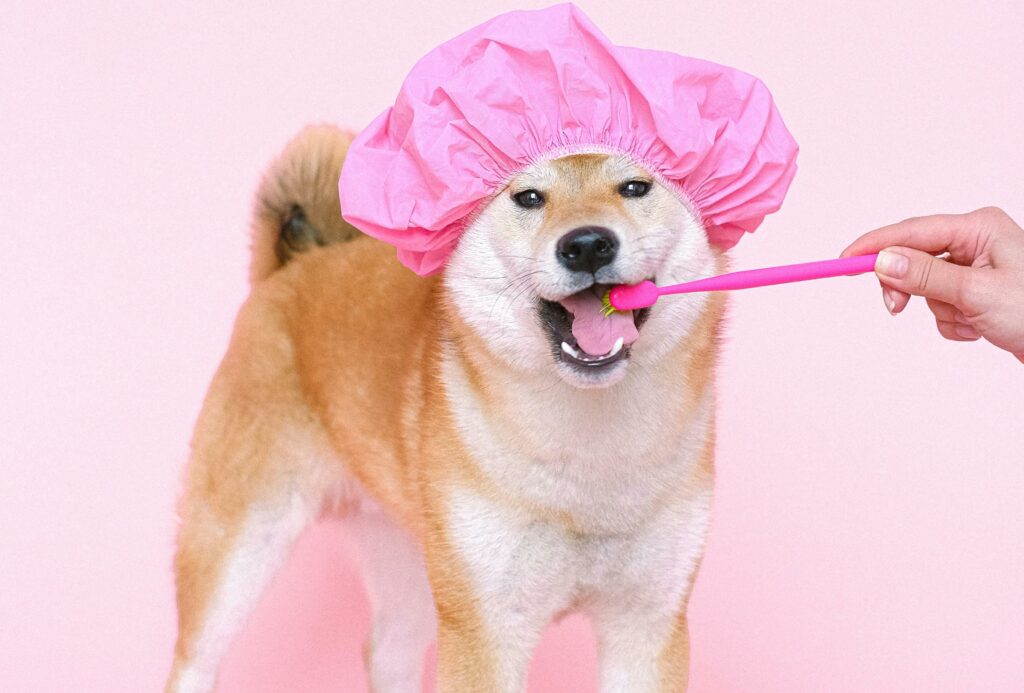Calling all fellow dog lovers!
As a dentist, I spend a lot of time educating my human patients about the importance of oral health, but it’s just as important for dogs too. Did you know that 80% of dogs exhibit signs of periodontal disease by the age of two? This can cause painful chewing, bad breath, and tooth loss. Moreover, bacteria from periodontal disease can enter the bloodstream and affect major organs, leading to more serious health issues.
Just like in humans, maintaining your dog’s oral hygiene is key for their overall well-being.
Fortunately, keeping your dog’s teeth healthy doesn’t have to be a daunting task. Here’s a comprehensive guide to everything you need to know about caring for your dog’s pearly whites.
1. Establish a Brushing Routine
Just like humans, dogs need their teeth brushed regularly. Plaque and tartar buildup can lead to gum disease, which affects the gums and bones supporting the teeth. To prevent this, ideally, you should brush your dog’s teeth daily, but a few times a week can still make a significant difference. Use a toothbrush and toothpaste specifically designed for dogs—human toothpaste contains fluoride, which is harmful to them. Start slowly to get your dog accustomed to the routine. Praise and rewards can make the process more enjoyable for your pup.
After introducing brushing sessions to my dog as a puppy, she has grown to love the routine – especially because of the tasty chicken-flavored dog toothpaste. The specific toothpaste we use is Virbac C.E.T. Enzymatic Toothpaste – it is consistently one of the top rated doggy toothpastes and the most frequently recommended by Veterinarians.
2. Dental Chews and Toys
Chew toys are not just fun; they also play a vital role in dental care. Chewing helps to naturally clean your dog’s teeth by reducing plaque and tartar buildup. Opt for durable, non-toxic chew toys that can withstand your dog’s chewing habits. Regularly inspect the toys for wear and tear to ensure they remain safe for your pet.
Incorporating dental chews that have been approved by the Veterinary Oral Health Council (VOHC) like Greenies Dental Treats and Oravet Dental Hygiene Chews is also a great idea. Plus, it’s super convenient and most dogs love them. My dog would do ANYTHING for a Greenie. Just make sure to get the right size for your dog to prevent any choking hazards.
3. Healthy Diet
Diet plays a significant role in your dog’s dental health. High-quality dog food can help reduce plaque buildup, and there are even some dog foods that are specially formulated to promote dental health. Look for kibble with a texture that has been shown to help clean teeth like Hills Science Diet Oral Care.
There are also many pet owners that prefer to feed their dogs a raw diet and have touted its ability to keep their canine’s teeth clean. These owners typically attribute this to the chewing of meaty bones and the minimal plaque formation due to the lack of processed foods. However, it’s important to note that American Veterinary Medical Association (AVMA) expresses concern over safety and nutritional adequacy of raw diets, and you should always consult your veterinarian about the best diet for your dog.
4. Hydration Matters
Ensure your dog always has access to fresh, clean water. Proper hydration helps maintain the health of their gums and teeth. Additionally, some pet water additives like Virbac C.E.T. Aquadent are designed to help reduce plaque and tartar. Always choose a product specifically designed for pets and follow the recommended usage instructions.
5. Regular Vet Check-ups
Just like in humans, routine dental check-ups are essential for dogs. During these visits, your vet will examine your dog’s teeth and gums for any signs of dental issues such as cracked teeth or periodontal disease. Professional cleanings, which may require anesthesia, are sometimes necessary to address more excessive tartar build-up. Your veterinarian can also provide guidance tailored to your dog’s specific needs.
6. Monitor Their Mouth
It’s always good to be on the lookout for any potential problems when in between dental check-ups. You don’t have to be a dentist or a veterinarian to give your dog a quick oral exam – you just need to know what signs to look for.
These can include:
- Bad Breath: Persistent, foul-smelling breath can indicate poor dental health.
- Red or Swollen Gums: Healthy gums should be pink and firm.
- Difficulty Eating: If your dog seems to have trouble chewing or is reluctant to eat, it may be due to dental pain.
- Loose or Missing Teeth: This can be a sign of advanced periodontal disease.
- Excessive Drooling: Often associated with oral discomfort.
Brushing your dog’s teeth is an ideal time to check for these signs.
7. Oral Health Education
Educate yourself about your dog’s specific breed and potential dental issues they may be prone to. Some breeds are more susceptible to dental problems due to their unique tooth structure or jaw alignment. Understanding these risks can help you take proactive steps to address them.
Final Thoughts
Maintaining your dog’s dental health is a crucial aspect of their overall well-being, longevity, and quality of life. By establishing a regular brushing routine, choosing the right diet and chew toys, scheduling regular vet visits, and staying vigilant about monitoring their oral health, you can ensure your dog has a healthy mouth.
Remember, a little effort goes a long way in keeping your pup’s teeth in top shape, so start implementing these practices today for a lifetime of healthy teeth!
~Dr. Lee & her loyal canine companion, Naika the GSD

